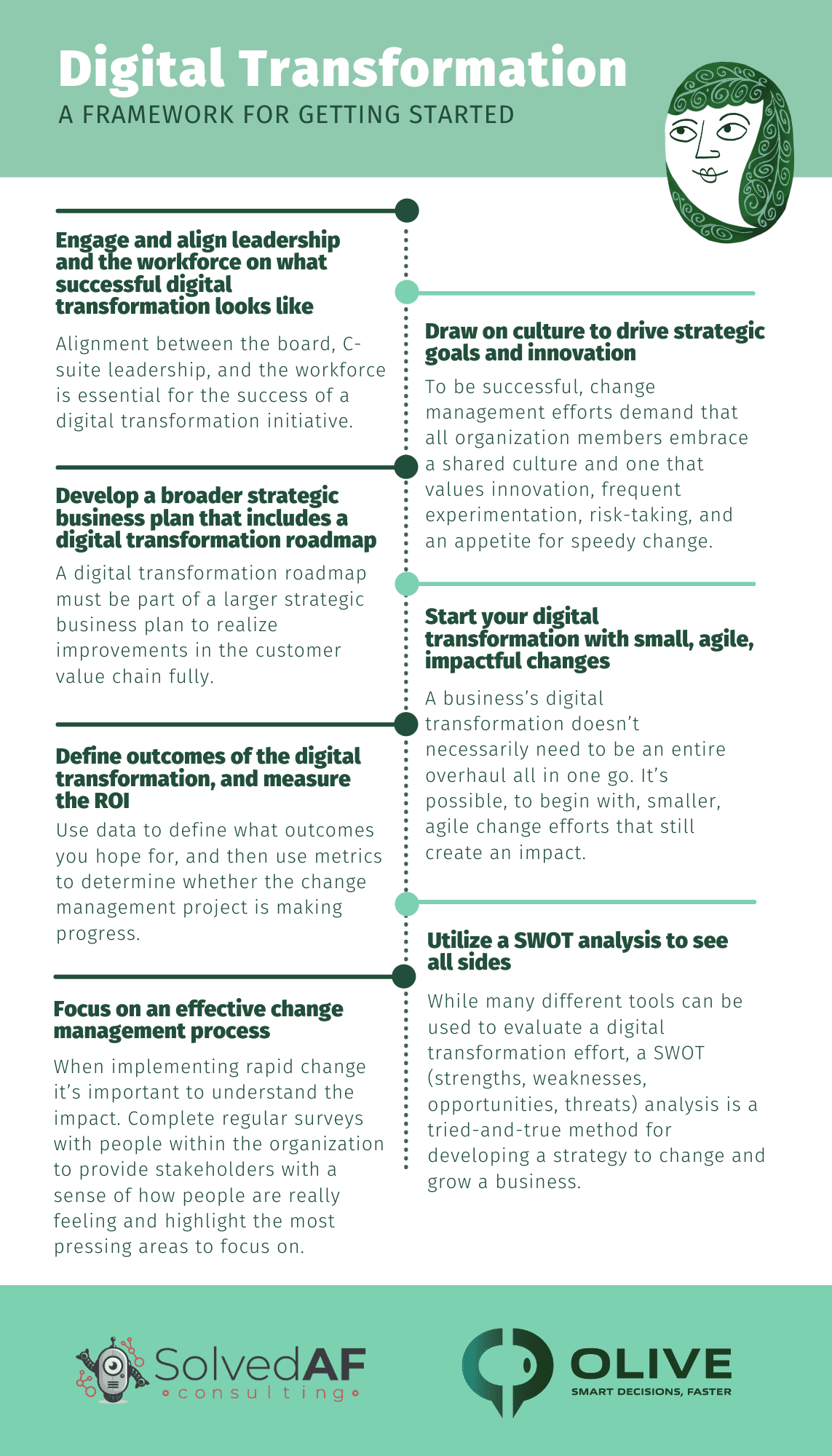How to Kick Off Your Company’s Digital Transformation
Digital transformation is a term that is often misunderstood. It can be used to describe integrating new technologies, automating operations, going paperless, or the rollout of digital products and services. However, a framework for getting started is much more than adding tech processes or bolting on a digital solution to an operational problem.
Transformation is the keyword. Simply put, it’s the act or process of transforming. For organizations, the digital transformation process encompasses enterprise-wide culture shifts that ask companies to embrace innovation, rapid change, and experimentation. In addition, the digital change process integrates technology into every aspect of an organization and transforms everything from business practices to customer experiences.
Understanding the Importance of Digital Transformation
The pandemic has only accelerated a previously existing rapid rate of digital transformation across industries. Non-digital native enterprises are forging ahead to tackle all kinds of challenges relevant to growth, customer service, the efficiency of operations, productivity, cost reduction, innovation, and risk management. According to the latest forecast by Gartner Inc., global spending on digital transformation reflects this increasing trend, to the tune of $3.9 trillion total in 2021. This is why having a framework for your organization’s digital transformation is so important.
Digital Transformation has moved from being a top priority to a necessity. Simply put, companies that don’t transform will not survive. Customers’ expectations have changed, and if you don’t meet them where they are, they will move elsewhere. Digital Transformation is also likely to reshape the economy. Agility, resiliency, and a digital-first strategy are crucial to determining a business’s economic success and risk in the future. As Forbes put it;
“That’s why we’re not going back to the normal we had before.”
A Framework for How to Get Started on Your Organization’s Digital Transformation
Although every organization will have different needs and demands, there are essential common themes that leadership ought to examine before embarking on a digital transformation journey.
1. Engage and align leadership and the workforce on what successful digital transformation looks like
Alignment between the board, C-suite leadership, and the workforce is essential for the success of a digital transformation initiative. The vision for change must come from the top. In instances where the board or executive leadership lacks the experience, knowledge, framework or mindset that leans into digital transformation, teams may end up frustrated by a lack of clear direction, eroding the trust factor towards digital transformation.
If there are knowledge or experience gaps in leadership, consider bringing in talent to be the bridge—or supporting leadership to give them the information and expertise they need. Essentially, digital transformation is a people issue, and it’s critical to get the right people with the right mix of talent on board. This could mean hiring mobile developers, project managers, an interim CIO, a change management leader, or using an agency to employ data scientists.
2. Draw on culture to drive strategic goals and innovation
To be successful, change management efforts demand that all organization members embrace a shared culture and one that values innovation, frequent experimentation, risk-taking, and an appetite for speedy change. If there are by-the-book employees who are reluctant to change, their resistance can derail digital transformation programs. Thus, engaging the workforce early on ensures the execution of a project that returns long-term business value.
3. Develop a broader strategic business plan that includes a digital transformation roadmap
A digital transformation roadmap must be part of a larger strategic business plan to realize improvements in the customer value chain fully. Most change management efforts stem from finding solutions to everyday issues that your customers or your business must deal with.
To begin developing a plan, ask questions about the pain points your customers and employees experience.
1. Which daily operational issues constantly cause problems for your workforce?
2. What have your customers said that they want – and that you don’t provide?
3. Which pain points have your customers described in their pre-purchase, purchase, and post-purchase journey with your company?
Once you have a detailed and relevant list, ensure that stakeholders and leadership review items against the following questions:
1. Does finding a solution to this problem align with the business’s strategic goals?
2. Will the solution deliver the desired return in investment (ROI) in the form of revenue, efficiency, or soft values like customer/employee satisfaction?
3. Is our enterprise able to implement the solution using internal assets, or do we need external support?
4. Start your digital transformation with small, agile, impactful changes
A business’s digital transformation doesn’t necessarily need to be an entire overhaul all in one go. It’s possible, to begin with, smaller, agile change efforts that still create an impact. The advantage of this approach is that there’s an opportunity to win over employees with incremental and iterative successes of an agile method. Learn from the process, and when the team is ready, take on that more significant transition.
5. Define outcomes of the digital transformation, and measure the ROI
Use data to define what outcomes you hope for. Then, use metrics to determine whether the change management project is making progress. For initiatives that may take many months or years to implement, evidence of movement and small successes is critical in keeping the workforce motivated. Data helps leadership see the impact of activities, detect delays, recognize trends, and make appropriate and timely alterations in course.
6. Utilize a SWOT analysis to see all sides
While many different tools can be used to evaluate a digital transformation effort, a SWOT analysis is a tried-and-true method for developing a strategy to change and grow a business. Further, SWOT analyses based on data, and not just assumptions or conjecture, will ultimately deliver a more accurate picture of whether the digital change initiative will triumph or stumble.
7. Focus on an effective change management process
When implementing rapid change in an organization, it’s important to understand the impact of that change. Complete regular surveys and 360 reviews with people within the organization to provide stakeholders with a sense of how people are really feeling. Doing so will generate noise but it could also highlight the most pressing areas to focus on. It can also improve morale, which is a key component of any successful change management effort.
Digital Transformation – A Solid Investment for the Future of Your Business
Embarking on a digital transformation journey is no small undertaking. However, with preparation and the right culture and talent in place, digital transformation will ensure businesses are;
- Better aligned with customer and employee needs
- Better able to navigate the digital futureInvesting in digital transformation support pays off in the long run.
About the Author – Ashiq Ahamed
Ashiq is a CIO & Digital Transformation Consultant, and Managing Partner at SolvedAF Consulting, a boutique management consulting firm that helps organizations implement transformative change through digital transformation, growth advisory, and risk management services.
Acknowledgments
The Day Digital Transformation Became Mandatory





